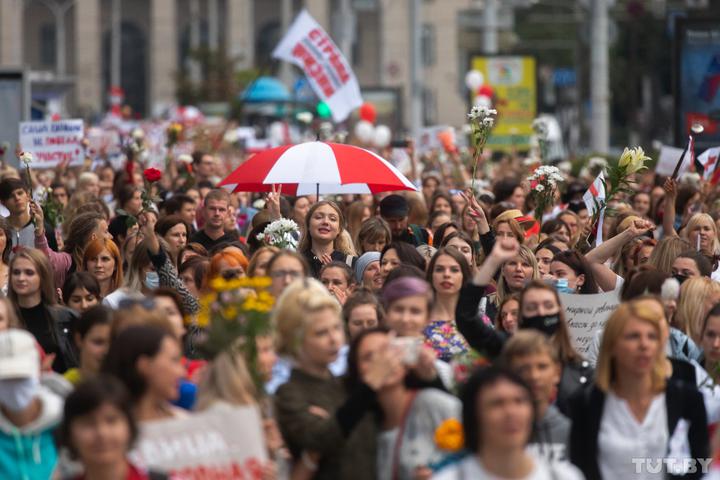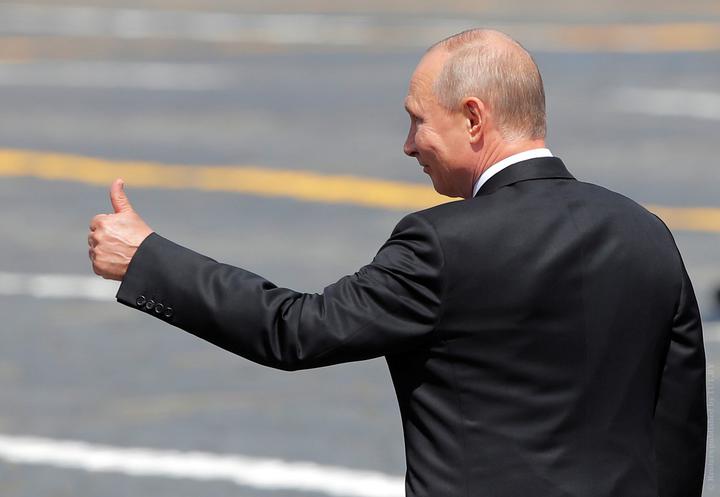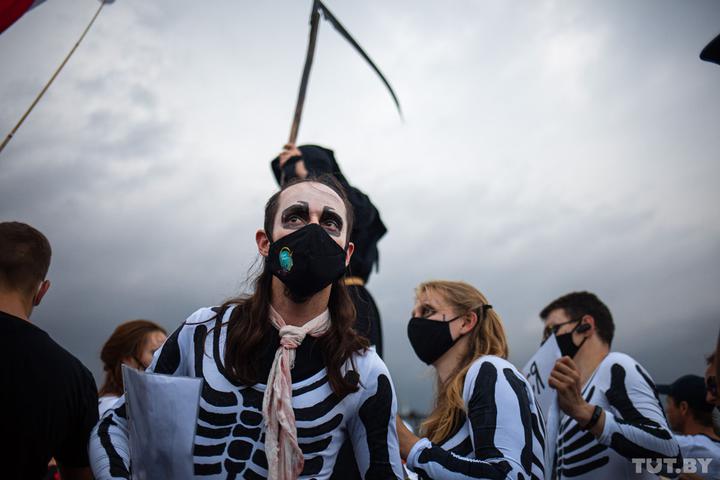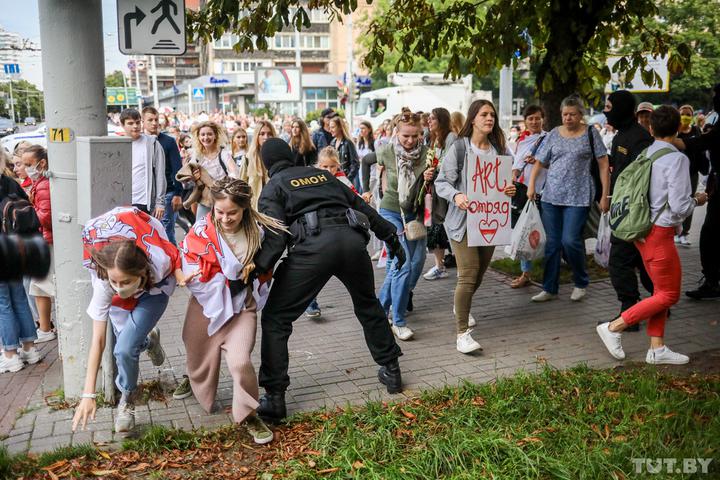Chaly explains why
1 September 2020, 11:36 | Volha Loika, Siarhei Chaly, TUT.BY

Source: TUT.BY
Despite the skepticism, protest activity in Belarus is not winding down. Recently, in the fight against protesters, Vladimir Putin and the support promised by him have become an important argument. Analyst Siarhei Chaly argues about the worthiness of such promises, the path awaits Belarus and why the decentralized protest turned out to be so large-scale and radiant.

Siarhei Chaly
Independent Analyst

Volha Loika
Chief editor of the political and economic news block
Listen to the podcast on Apple Podcasts
Listen to the podcast on Google Podcasts
Listen to the podcast on VKontakte
Listen to the podcast on Yandex Music
Listen to the podcast on Castbox
Putin, save us!
“One of the most common questions that have worried Belarusians in recent days is how to treat the threat of Russia and the constant appeal of Aleksander Lukashenko to Putin: from Putin’s discussion with third countries about the fate of Belarus to the “reserve” that is preparing to help Belarusians. Is it possible to accelerate the integration of Belarus with Russia, or even its incorporation?
In economics, there is a concept of verbal intervention. The master of this was Eisuke Sakakibara, a former Japanese finance minister who was nicknamed “Mr. Yen”. If he voiced a desire that the yen should cost not 135 to the dollar, but 145, yen would go down, although the authorities did nothing for this. The trust was so immense. Everyone knew: if he wanted, the currency would go to the desired rate. In Belarus, verbal interventions also work: let’s recall the famous promise “there will be no devaluation”. In the case of Russia now, these statements are precisely that – verbal interventions. I do not believe in Russia sending troops or security forces. This “reserve” is only needed to have something to answer Lukashenko with”, Chaly says.
No “people’s republics” like the DPR and LPR are possible in Belarus due to the fact that all polls show unambiguously: the attitude towards Russia is good, but there is no desire to be in a united state.
“And there will be no Crimea in Belarus. Moreover, both the army and the units of territorial self-defense have been trained to work according to the scenario of blocking administrative buildings and creating “people’s mayors”. They will not shoot at the local population”, the expert believes.
It is much more important to understand, the analyst notes, what Russia’s long-term plans for Belarus are.
“It seems that these plans have changed a lot after the elections. I believe that the goal of Russia is not incorporation, but the creation of a very weak state dependent on Russia. The hopes that Moscow will suddenly help with money are empty. And the discussed billion dollars to refinance the Belarusian debt to Russia is a drop in the ocean. This is akin to the $ 6 billion that Medvedev allegedly offered to Lukashenko in 2011. In the end, there were no “billions”.”
Russian analysts argue that Putin is making a mistake by supporting Lukashenko’s regime. They say “the dictator extends his hand to the dictator”. And, in doing so they have dictatorial internationalism. In fact, he does not make any mistake, Chaly is sure.
“Putin’s entire strategy towards all countries, including ours, remains unchanged throughout his presidency. Suffice to recall his 2015 keynote speech, where he directly speaks about the support of sovereign regimes in their struggle against the people and democratization allegedly imposed by the outside forces.
They did not invent anything new for Belarus in Russia. From his first steps as the president, from his visit to Kim Jong-il, Putin tried to sell himself to the West as a man one could use to talk with unpredictable regimes and their rulers. It was the same with Syria and so on.”
Chaly notes that Syria is just a good example of Russia’s actions.
“What is Russia doing in Syria? It is actually trying to negate the whole world’s attempts to somehow normalize the situation in a country with rebellious people and a dictator who would have been removed long ago if not for the regular military aid from Russia. There is no strength to demonstrate oneself on the world arena, but just enough to negate the results for others completely. Claiming that “you can’t cope with Assad without us, let’s sit down and talk”. Russia wants an equal conversation with the United States, with other countries – this is the goal, not Syria. So in case of Belarus, his goal is to impress the West. Therefore, Putin is making sure that the leaders of Western countries discuss the fate of Belarus not with Lukashenka, but with him. He is sure – this is his sphere of influence.”

“As a result, with the participation of Russia, “abscesses” are created, primarily in the post-Soviet space,” the expert emphasizes. “Thus, in Georgia, territories, primarily from South Ossetia, were seized to create an eternal problem. Similarly Donetsk and Lugansk were created.”
“Or Transnistria. Now it is obvious that this is the same thorn in the body of Moldova. I talked a lot about the path for Belarus. We could follow the Estonian pattern with its digitalization, small government, export orientation. If the course is not changed, Belarus could become a big Moldova. But the scenario that Putin is presenting to us today is even worse: we risk becoming not Moldova, but Transnistria. This is, most likely, Putin’s long-term goal. This is the worth of Russian support. Not occupation, not integration, not intervention, it’s the creation of abscesses in the body of another country.”
Belarus could become a big Moldova. But the scenario that Putin is drawing for us today is even worse – we risk becoming Transnistria. This is, most likely, Putin’s long-term goal. This is what Russia’s support is worth.
The expert believes that “Putin’s” Belarus is a country with a weak, dependent economy, a weak judicial system, and the impossibility of property rights protection, as Lukashenko himself said (pointing out that only a private trader loyal to the state will receive equal conditions with the state sector) is a guaranteed zero investment activity, both external and internal.
“The country will live on minimal external support. Akin to Transnistria, which does not pay at all for the consumed Russian natural gas. These debts are paid by Moldova. At the same time, the country loses its foreign policy subjectivity. All external affairs will be decided by Putin. Domestic effective demand collapses to a minimum. Everything that is alive, capable of moving and working in a normal modern economy, will leave the country. The archaization of the country will occur. Gradual decay with a complete lack of prospects. There will be no economic growth,” the expert says.
Carnival in Belarusian or Protest without a leader
Over the past weeks, everyone in the world has appreciated the creativity of the participants of the Belarusian protests, messages and posters are becoming more and more sophisticated. Chaly is confident that we are preparing to surpass European demonstrations and carnivals.
“A giant cockroach, death with a scythe, posters like “There should be a woman in the house… In the House of Government”, “Russia Today – The Hague Tomorrow” [and more elaborate world play which can’t be translated reliably without loss of meaning] – such carnivalization performs several important functions. I once made a project “for the record” – a guide to a city Minsk will be if we get rid of all this. And there was an idea to hold an annual festival, where half of the participants dress up in the costumes of the riot police, and the other half in the opposition. And they arrange epic battles among themselves like battles with tomatoes. It seems that we are close to implementing this idea,” says Chaly.

Source: TUT.BY
At the same time, every two or three days, conversations escalate that everything is lost and the protest has dissipated, soon everyone will be jailed either together or separately, different scenarios of defeat are offered. Now this narrative, the expert notes, is starting to fade away. People are beginning to understand that this struggle is not fast. It is the struggle of attrition. And the protesters have a lot of resources.
“Currently popular Russian political scientist Maksim Katz said a very important thing: everyone pays attention to the state of people who come out to solidarity actions. But look what is happening on the other side of the barricades. The authorities are doing everything to extinguish the protest. They promised it by last Monday. But, somehow, the protest is not winding down. They were shooting, throwing grenades, beating and torturing, the Internet was shut down, they threatened with Russian intervention, detained, abducted and fired activists. The president already paced around with an assault rifle. Nothing is working. Lukashenko still cannot understand where so many people on the street came from. He raised everyone, fed everyone, built all businesses, as in the Gospel of John the Theologian “In the beginning was the Word, and the Word was with God, and the Word was God. He was with God in the beginning.Through him all things were made.” And what do people want? Participation in choosing the fate of the country? But it is there! Not for everyone, really. But why should everyone have it anyway? The government feeds everyone – what else do you want?”
They [government security forces] already shot at, threw grenades, beat up, tortured, turned off the Internet, detained, and fired those who disagree. The [ex] President even made a show with a machine gun. Nothing works. Lukashenko still cannot understand where all those people on the streets are coming from.
“And this feeling that nothing is working out gives rise to important emotions”, Chaly proclaims. “Continuing the metaphor of this campaign, the metaphor of the tyrant of the house, if you do not succumb to this violence, then the aggressor feels powerless and desperate. And if there are problems with working out the feeling of powerlessness, if the emotional part prevails in the aggressor over the rational one, and then it gives way to hatred and rage.”
“This is a way out through affects, not rational reasoning. A person cannot understand that basic existential values are stronger than fear. He thinks in other categories like bread and flour. And people are already higher in the pyramid of needs, they see the world wider than the one who controls them,” says the analyst.
“The state of rage and hatred is a very energy-intensive state, it consumes forces”, Chaly continues. “The longer you are in this state, the more irrational actions you commit, the less trust you have from the people, your own political environment and your opponents. This is a war of attrition. Not physical, but emotional.
And vice versa, carnivalization is a self-sustaining process. Horizontal connections work, people recharge from each other. So the strength of one is weakening, the others is growing”, he notes.
How the horizontal beats the vertical
Those who said that the protests would quickly weaken, underestimated the strength and resources of the horizontal network, the expert is sure. Indeed, many are still convinced that a hierarchical pyramid works better than a horizontal network.
“The Aztecs had a well-established, centuries-old hierarchical structure, but after the elimination of the leader, the empire collapsed. And if the ruler is gone, if every village is self-governing, the offensive gets stuck, stalled. Courage, the will to continue acting in a horizontal network is not individual, but powered by the charge of the others. It matters not how brave you are, but how you assess the bravery of those around you. At mass actions it works when the actions of one person are visible to everyone else, and sooner or later it becomes simply a shame not to participate – everyone is there, after all”, says Siarhei Chaly.
“Underestimating modern organizational structures in comparison to old ones is a standard mistake of many political scientists and experts,” he is sure.
“All the questions like “what will you do if you are imprisoned?” are precisely because of the confidence that only hierarchical structures with a leader specific organizers can work. The Saturday women’s march with its irrationality, some chaos, their “A-ah! We surrounded the riot police!” stays in contrast with this belief. Ideas are born locally and quickly passed through the screenings – what works is immediately adopted. This is the spread of micro-innovation, like the idea of folding a ballot in a form of an accordion. It works great. The authorities and pro-government experts still think that they are fighting organized resistance”, the expert says.
Current government and pro-government experts still think that they are fighting an [externally] organized resistance.
To explain what is happening, Chaly notes, there can be two hypotheses: that there are either some unknown coordinators who have just unlimited resources, the confrontation with all these Rubezh vehicles and APCs (armored personnel carriers) are very expensive, or there are some kind of previously unseen technologies, hence the belief that people do not come out on their own, everyone has been brainwashed, and this must be opposed by radio and leaflets, as it has been during World War II.

Source: TUT.BY
Chally is assured that pro-government experts are hopelessly behind the times. Here is a political scientist, Ph.D. Nikolai Shchekin says “A well-known four-stage model of hybrid war is being implemented in Belarus: from Telegram-revolution into diplomatic war then “humanitarian aid” which concludes with direct military invasion”.
“In their minds there are some invisible leaders, elusive hierarchical structures with general training. They were preparing to fight the street – a controlled, organized, and perhaps even armed crowd. Under it, all this equipment on the streets, water cannons, chains makes sense. We cut, surround, disperse. Instead, there is a cute chaos of the women’s protest, where it is generally not clear what is happening. Men are powerless before it. All these chants like “you won’t get any [sex], it’s terrible,” the expert smiles. “It’s such a low blow that it’s just a nightmare. And many believe in the power of the collective female curses. Terrible weapon.
Now Belarus is showing the world how a truly dispersed protest works,” Chaly is sure.
“By the way, the experts of the “couch military forces”, NEXTA and alike, were also mistaken. They said, if we don’t press on now, if we don’t storm television, Akrestsin Detention Center, administrative buildings, the protest will be blown away. Well, how about no. The people are well aware that strength is not in this. Not in an armed offensive, not in barricades. This is a completely different paradigm of resistance, and note that it happens exclusively within the framework of a nonviolent trajectory.”
Import propaganda: how it works
Last week, Russian propagandists were added to the Belarusian ones. They were invited to the Belarusian television to help their colleagues. But will this work?
“It is important to understand how propaganda differs from news. They say that propaganda always lies, even when it speaks the truth. This is a special way of presenting information. Watch Russian channels, they are filled with hysteria and screeching. It is unsafe for having peace of mind, and so we imported it all”, the expert states.
Chaly notes that the propagandists are rather clumsy at work. As a result, initiatives are born, such as the rally of police trucks under red and green flags, reinforcing the feeling: this is the flag of those who torture.
“Look, the rallies in support of the president are conducted, helicopters with flags fly, bicyclists are riding. The question, though, is what kind of emotion do you want to evoke by this. Propaganda is the right to hate. And, as I said, when one side emits hatred, the other side just needs to radiate love.”

Source: TUT.BY
The expert is sure that propaganda works up to a certain limit. It’s like spam – why keep sending it? Because it works. So it is in this case: there are people, who are subject to this.
“It is interesting that in some places the propaganda is completely out of touch with reality. And then there are statements that three million people came out in support of Aleksander Lukashenko. I would say it is true only if three million are counted in the old currency, before the denomination [by ten thousand]”, the analyst smiles.
Chaly is confident that Lukashenko is again acting like Trump, with whom they are similar in psychotype. When he is feeling the loss, he works to split the society, to incite hatred and to mobilize his supporters.
“Even this famous stunt with a helicopter, machine gun and with Kolya [his 15 year old son] in full gear is taken from the Trumpists’ playbook. Like Trump’s retweeted photo of the St. Louis couple.”
“What effect should the photo and video of a person with a gun be? “I’ll scare you now!” But it turned out to be a pity: the president showed his loneliness. I am not even mentioning the fact that not every Rambo goes to war accompanied by a personal doctor with a first aid kit. It looks ridiculous”, says the expert. “No Trump playbook will help here: the remaining support groups for the president are scattered, they cannot mobilize. The split will not work. The majority is on the other side.”
Expert’s opinion might not coincide with the editorial’s position.